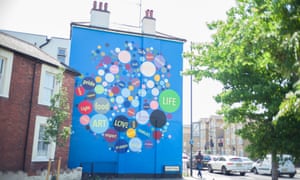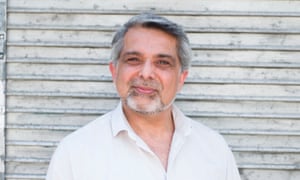
Rhoda Ibrahim had been excited to celebrate International Women’s Day. The community leader, 57, has spent three decades championing the rights of Somali and minority ethnic women in the north-west London borough of Brent. After going to a council event in the early afternoon – the theme was “Each for Equal” – she headed to the local Queens Park community school. Her organisation, the Somali Advice and Forum of Information, had helped to arrange for a barrister, who had come to the UK as a child refugee and been raised on benefits in the local community, to speak about the many barriers to social mobility in the UK.
Ibrahim was pleased with how the day had gone. Her friend Hassan Farah, a local teacher widely credited for helping four British-Somali students from Brent get into Oxbridge – a first for the community – offered to drive her home. “He was not just a teacher, he was an incredibly kind man, a role model, a mentor and a father figure for children like mine. I have three boys and I couldn’t have raised them without him,” Ibrahim said of Farah. She waved goodbye as his car drove away, not realising it would be the last time she saw him.
Ibrahim, Farah and several other attendees of the school event fell ill with coronavirus symptoms shortly afterwards. Farah, who taught for more than 20 years at what is now Capital City academy, slipped into a coma. “I prayed for him every day, I thought he would recover, but he died six weeks later,” Ibrahim said. The school he worked at described him as a “a kind, generous-hearted, intelligent man who gave so much to us all.”
At least 36 residents have died in Church End, a small, deprived estate in north Brent with a large British-Somali population. Locals believe the cluster, which is the second worst in England and Wales, according to the latest data from the Office for National Statistics, does not account for the true scale of the devastation, as it does not factor in people who work in Church End but live nearby. Overall, Brent has the highest age-standardised coronavirus death rate in England and Wales. Excess deaths in the borough are three times the national average.
Ibrahim has not had time to process, let alone grieve, the coronavirus deaths in Church End. They include people such as Abdiqaadir Mohamed Farah, who ran a business in Hammersmith and helped get young people into sports. He died on 24 March. Aweys Ahmed Imaan, known locally as Sheikh Aweys, was said to sell the best halwa, a popular Somali sweet, in his shop on Church Road, where there are a string of Somali cafes and stores. He died on 29 March. Musami Mursal Abdi, a tailor who migrated to the UK in the 90s and was a pioneering figure in the community, also died. Many of those who died were men aged in their late 4os to early 60s.
While the local Somali population has been hammered by Covid-19, it is by no means the only community to suffer. A British-Pakistani man who worked as a butcher on Church Road died after getting the virus. Alem Goitom, 61, a recently retired bus driver from Eritrea, died in late April.
***
When coronavirus first emerged in Wuhan and rapidly spread around the globe, it was described as the great leveller. But on a blisteringly warm Wednesday on Church Road, where many of the shops remained closed, the brutal injustice of Covid-19 was laid bare.
The virus thrived on the structural inequalities that Ibrahim had spent much of her life fighting. It flourished in a housing crisis that was 40 years in the making, stark in-work poverty that left many struggling to put food on the table, and deeply entrenched racial inequalities.
Feelings of frustration, desperation and anger were palpable on Church Road. “We could have saved so many lives if we had gone into lockdown earlier. So many lives,” Ibrahim said.

In February, before the pandemic hit the UK, Brent council set up a poverty commission, led by the crossbench peer Richard Best, to understand the hardships its residents experienced. Figures show that around a third of employees in Brent earn below the London living wage, a third of households claim housing benefit and nearly one in six are in fuel poverty.
Poverty rates in the borough stand at 17% before housing costs; when housing is factored in, the number shoots up to 33%. “If I was to have one takeaway so far, it is that the expenditure on housing is impoverishing the people of Brent,” Lord Best said. One resident told the commission: “It just upsets me. I keep thinking: what if they evict us? What am I going to do? Is just scary. I’m always crying and in distress.”
Many poorer families who want to be in council-owned properties and pay affordable social rent are instead in private rental properties, with significantly higher charges that they struggle to pay, or in temporary accommodations. John Boughton, a social historian and author of the book Municipal Dreams: The Rise and Fall of Council Housing, said it is a story that resonates across London and much of the south-east.
The ingredients for the current crisis date back to the election of Margaret Thatcher’s Conservative government in 1979, Boughton said. “There was a sea change and it came with a basic presumption against council housing, which was legislated in a series of major policies. These policies weren’t substantially challenged by the New Labour government in 1997 to 2010.”
In 1980, almost one in three households lived in council housing in the UK. With the introduction of right to buy and restrictions preventing local authorities from building more social housing, the figure dropped to around one in six.
As council properties were sold, several waves of immigrants settled in Brent. Leroy Simpson, a well-known community champion who set up the Harlesden Mutual Aid group and has lived in the borough for 50 years, said: “When you walk down the high street, you’re feel like you’re doing a world tour because there’s so many different named cultures who all share space.” Large Irish and West Indies populations established themselves in the 50s and 60s and they were joined by people from Pakistan, Somalia and, most recently, Brazil.
Many settled in houses and flats that had been sold to private landlords. Some are in terrible condition, while others are too small for their occupants. “Residents who are on our housing register and who are experiencing poverty in the borough need three-, four- or five-bedroom homes. It’s great that developers want to come to Brent, but blocks and blocks of one-bedroom apartments don’t help me from [a] housing perspective,” said Eleanor Southwood, the local council’s lead member for housing and welfare reform.

Anisa Mohamed, a 21-year-old English student who lives in Church End, said overcrowded housing had limited the life chances of the younger generation. “It’s hard for young people to study then come home to overcrowded houses. My friend would have three assignments to do in like two weeks with one laptop that they’d have to share it with everyone in their house. They also have to share a room with two or three other people. There is just no space.”
That lack of space would go on to become a significant risk factor for getting coronavirus. A study published in April found that overcrowded living conditions were probably accelerating the spread of the virus.
Many of the workers in Church End are on the frontline: carers, bus drivers, cleaners, postal workers, shopkeepers and taxi drivers. Without PPE, some picked up the virus and unwittingly brought it back to their homes, where parents and grandparents reside and there is no room for vulnerable people to shield. Others live in multi-occupancy homes where families share toilets or kitchen facilities with others.
Anisa Mohamed’s father, Abdillahi Mohamed, who runs the organisation Free the Forgotten and has an office in Church Road, said the severity of the virus did not dawn on the community until it was too late. “Information wasn’t provided early enough in Somali. People were abandoned.”
***
At the beginning of the crisis, Ibrahim was fielding more than 150 calls a day from local residents, largely Somalis, desperate for help. Some had family members who had gone to hospital and died, and they didn’t understand what had happened. Others had lost the main breadwinner of their family and needed basic necessities such as food. “There was a total collapse of the system in the beginning. I was doing the same work I did on the frontline with UNHCR in refugee camps in Ethiopia, Djibouti and Yemen in the early 90s.” Many of the people who needed help were war survivors who had been severely retraumatised by the pandemic, she added.
Victoria Ling, who was born and raised in the borough and works there as a nurse in a GP practice, is still struggling to comprehend the scale of suffering among certain communities. “We’ve had households where whole families have been wiped out,” she said. She is shocked that many of her patients who died were in their 40s and 60s. “I was talking to patients who would say my aunt has died, my uncle has died, my dad has died. It was literally every day.”

Muhammed Butt, the council leader, was not surprised that Brent had the highest Covid-19 death rate in the country. He needed only to look to his own family to see the impact the virus had had on his local community. “My mother-in-law ended up in Northwick Park hospital on a ventilator. She’s now back home, but she’s still so weak. My 62-year-old cousin passed away, and then her cousin, who lives just further down the road, who was only 64, passed away. And, even closer to home, my own grandmother died. I could see it happening quite quickly, in front of my eyes. It’s quite heartbreaking.”
While the council was able to mobilise quickly and protect care homes, it struggled to contain the death toll in the wider community. Butt believes the government’s failure to provide tailored support to communities like those in Brent worsened the situation, and that the country should have gone into lockdown earlier.
There are immense challenges ahead for the council. As well as having the highest death rate, Brent has the highest number of furloughed workers and has seen a significant spike in universal credit applications. And there is the fear of a second wave. Butt called on residents to use a testing centre set up recently in Harlesden, and to otherwise stay at home when they can.
Ibrahim described the Harlesden Mutual Aid group as a lifeline in the early weeks of the pandemic. She believes many people would have gone hungry if it wasn’t for the support that Simpson and other volunteers provided. For Ibrahim, the mobilisation of mutual aid was not just an act of solidarity but, in its most fundamental sense, a powerful rallying cry that black lives matter.
***
Joshua Murray, one of three councillors in Harlesden, which includes Church End, can split his residents into two groups: those who have lived in Brent their entire life and those who recently moved in. Residents contact him mourning the death of another young person shot or stabbed, or complaining about a cracked pavement. “These are two different worlds that are in the same environment,” he said.

The pandemic has in some ways bridged the divide. “We’re seeing a return of the community spirit we had in the 70s and 80s,” Simpson said. “People are actually looking out for each other now.”
But the tensions have not disappeared entirely. There was a backlash when 500 largely young black residents congregated for a block party in Church End in early June. But Ricky Gardner, 46, who runs a youth training company, Revoseccus, saw long sought-after unity in clips of young people from different areas in Brent partying together. “That there were no major issues within the block party shows that whatever personal squabbles they may have had have been resolved. They’ve seen a bigger picture.” In an area that has been blighted by gang violence, that fragile unity is an important step forward.
Gardner has also been impressed by how many young people are making links between structural racism in schools, on the streets and within the NHS. “Young people are more socially aware today. If you look at the difference to how they responded from Mark Duggan [whose 2011 killing by police triggered the London riots] to this, it’s still young people both times but it’s a totally different response.”
Back on Church Road, Ibrahim stopped to speak to everyone she knew, keeping her distance but beaming. “There is this happiness when you see someone because you know they are alive,” she said.

She entered Fatuma Abdi Jama’s shop, which had reopened a few days earlier. Jama, who is diabetic, has high blood pressure and heart problems, also contracted the coronavirus. When she called for an ambulance after her breathing difficulty became so severe she thought she was going to die, she was told there was a seven-hour wait. She called again but was rebuffed.
“The ambulance wouldn’t come for people and you can’t breath,” she said. She resorted to drinking vinegar to help ease her breathing. Although she eventually recovered, she said she still felt pain in chest.
George Floyd’s cry that he couldn’t breath happened thousands of miles away, and related to police violence, but it has resonated deeply and widely here.


